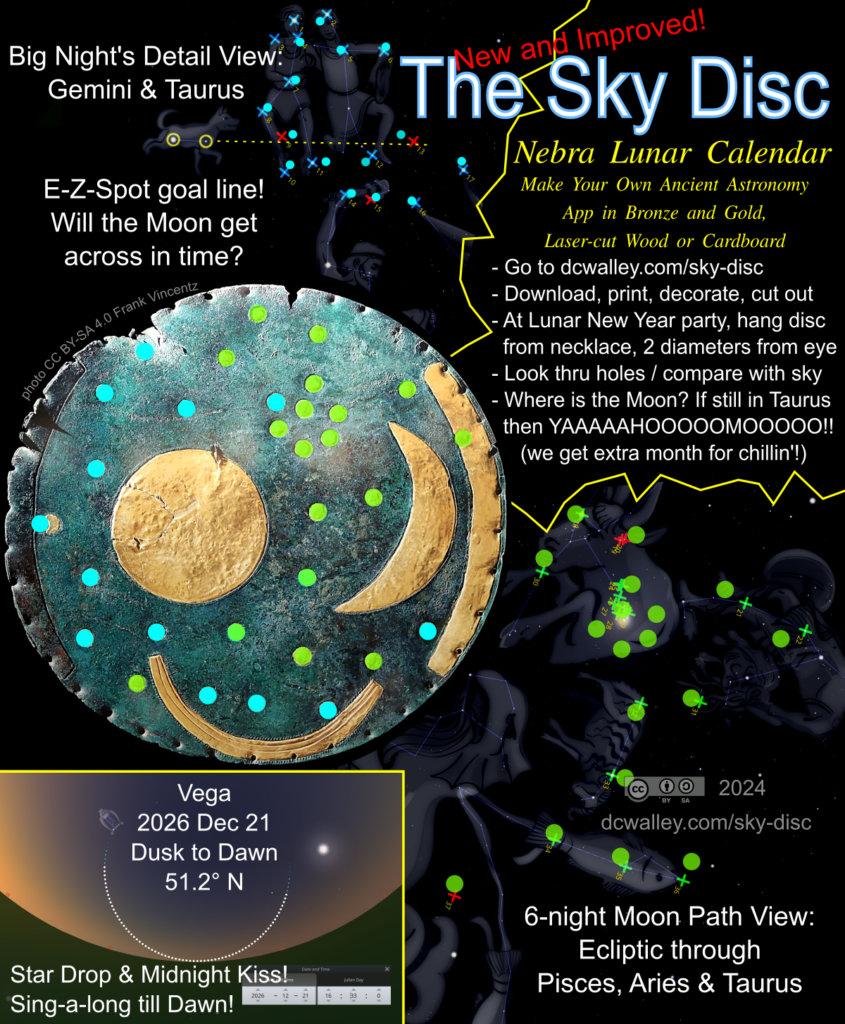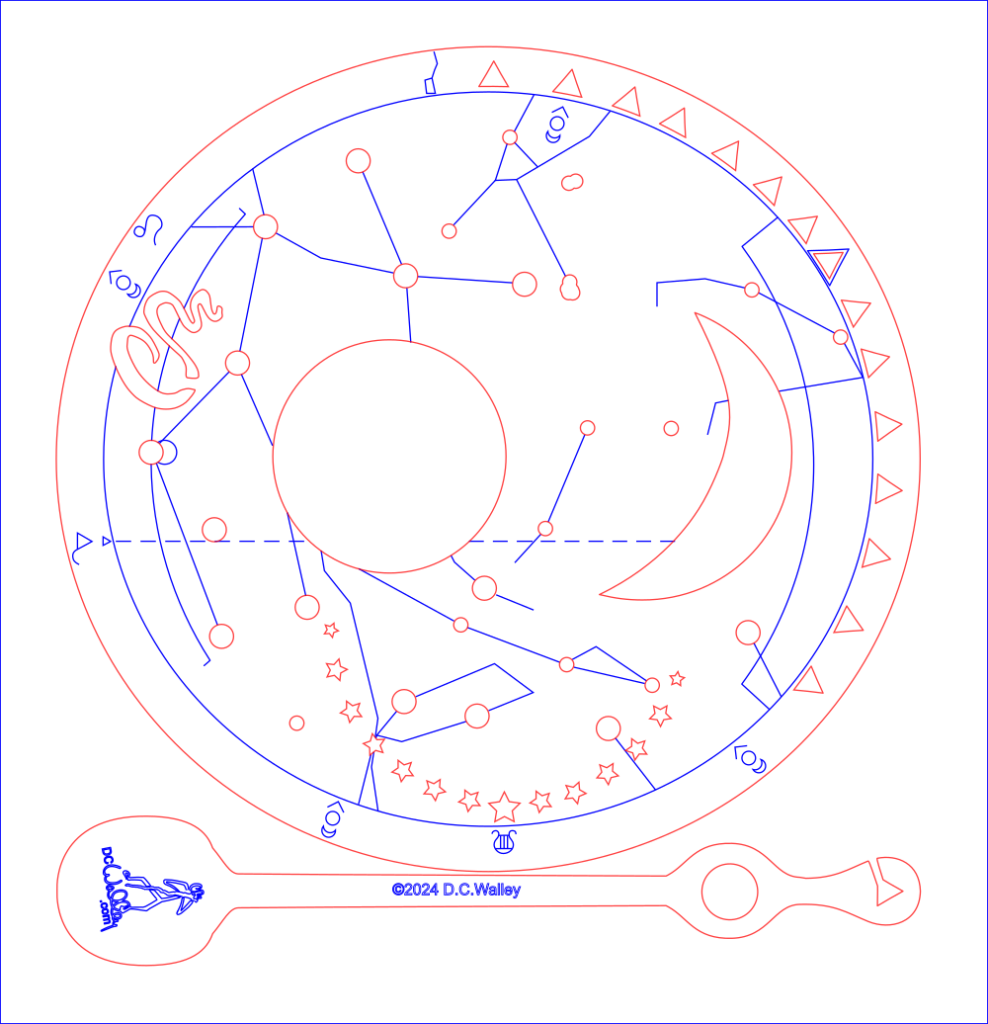
New and Improved Sky Disc
You can track the progress of the Moon, and determine whether the New Lunar Year needs an extra month or not, with our New and Improved Sky Disc. While we don’t claim that the Nebra Sky Disc was used this way, we think it is fun to print our version on cardboard, cut along the red lines, decorate to make it yours, take it outside at night, and decide for yourself.
But wait, there’s more!
If you act now, you can include the wizard stick. Hook it onto the same loop as the disc, and look for the added surprise! Only with our New and Improved Sky Disc!

Instructions for Use
Print graphic on cardboard (laser cutting files coming soon).
Cut out along red lines. Optionally cut out all holes, so you can look through them to see stars in the constellations. If you don’t cut out all holes, you can simply hold your disc beside the constellations.
You will need holes for a necklace string. The string should be sized so that your disc is can be hung 2 disc diameters away from your eye.
To get the most use of your disc, live at 51.3° N. But you don’t have to move to enjoy your disc – check out the sky where you are instead, and use disc to compare with what can be seen at Nebra and Stonehenge.
Wait for the last month of the lunar calendar, usually called December, sometimes January, by those nutty solar calendar people. If you have kept your calendar count correctly, the zodiac from Pisces to Leo should be visible in the middle of the night.
Find a spot with a good view of as much of the sky as possible. The top of a hill is often a good choice. Check each night for the waxing crescent Moon, before it becomes 50% illuminated – 2026-12-16 for example. The last crescent moonset should occur around midnight.
Start count of nights when the Moon is 50% illuminated or more, 2016-12-17 for example, by threading necklace through the diamond perimeter hole. Keep count by moving the necklace 1 hole clockwise for each of the next 7 nights.
Find and track Vega, the brightest star in the West, as it drops, eventually kissing the North horizon, near midnight, and rising again in the East. If you don’t live at 51.3 degrees North as instructed, then make your best guess when Vega is directly below the North Star Polaris. Or set your smartphone to ring at midnight, cheater.
Hold up the disc by necklace threaded through the correct perimeter hole, hanging down from the Moon, but you can then grip it for observations high overhead. At one disc diameter from the eye, the size and orientation of the zodiac constellations Taurus, Aries, and Pisces, and Perseus above them, can be seen as depicted on the disc, or through the smallest holes in it, at the correct scale and orientation, each night. Note the position of the Moon in the zodiac, and on the disc. Remember this position for the rest of your life, so you can pass this information to the next generation through story or song. Or write it down. Or forget it.
Hook the wizard stick over the necklace and let it hang down in front of the disc. Look through viewport in stick to see an approximation of the phase of the Moon you should see in the sky.
On night 7, get ready for the big night!
At dusk, after sunset and full moonrise, look for Vega’s first appearance, and start singing “4999 Bottles of Beer on the Wall” at a walking pace. But you do not like “n‑1 Bottles of Beer on the Wall” you say? Well, you should have thought of that earlier. A 4-minute song would have reduced your torment by 2 dozen beers.
Move the necklace 1 hole anti-clockwise every 30 dozen beers (or hour). During the early evening, as the mood for star-gazing strikes, hang the disc 2 diameters from your eye. Gemini, Orion’s club, and the horns of Taurus can be seen on the disc, or through the bigger holes in it, very near the correct scale and orientation.
These stars rise during the early evening with the Moon. At around 3599 beers (20:30 or so), the head of Leo should be rising above the West horizon, as Vega is dropping. Adjust your singing tempo accordingly.
Vega drops until it kisses the horizon at midnight. If not, you do not live near 51.3 degrees North as instructed. That’s okay, you can estimate when you think Vega is due North, wait for 2999 beers, or set your smartphone to buzz at midnight.
Look up high. Is the full Moon in Taurus or Gemini? If a close call, use the two brightest stars in Canis Minor to start a line across the sky, and ask yourself which side of the line the Moon is on.
If a really close call, you can keep watching. The Moon gets lower, and you can keep the disc in the correct orientation as you continue moving the necklace one perimeter hole per hour, allowing the disc to hang and then gripping as needed, as you sight through it or look beside it. At 0 beers, around dawn, getting close to moonset, the line through Canis Minor will be parallel to the horizon when the bottom of the disc is aligned with the real horizon. You can then ask yourself whether the Moon is above or below the center of the disc.
If the Moon is judged to be in Gemini, then you are good to go with your lunar calendar for another year. If not, then everyone gets an extra lunar month in summer in the new lunar year!
There are multiple redundancies in the procedure, for example, a judgment call at midnight and one at dawn. This is so bad weather does not prevent a determination from being made in any given year. Consider the midnight observation as the main one, with dawn as a backup, but all observations made during the week leading up to the seventh night can also be used in a pinch if you ask an experienced Nebra sky wizard.